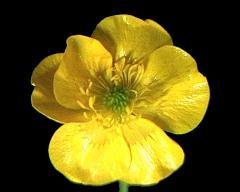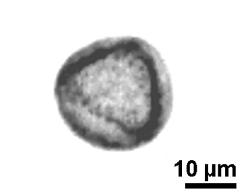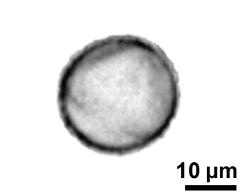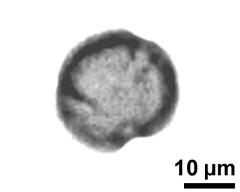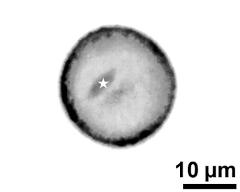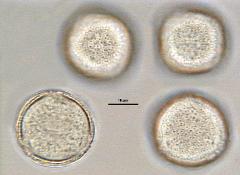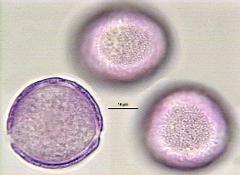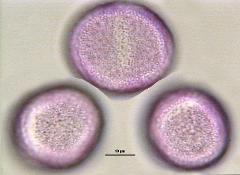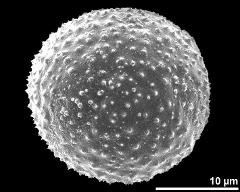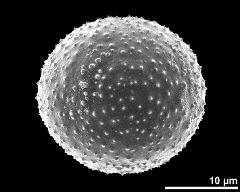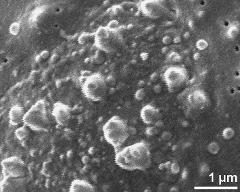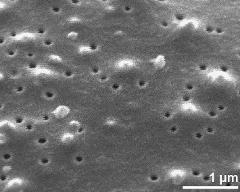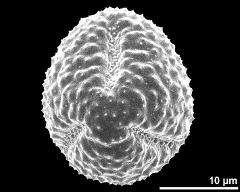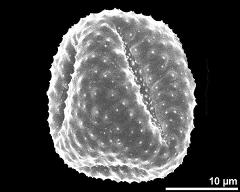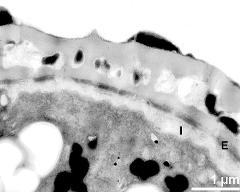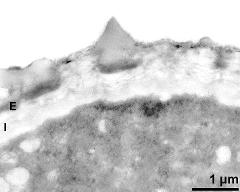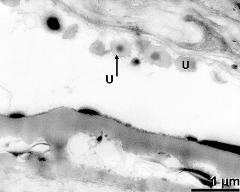Ranunculus acris
Taxonomy: Angiospermae, Ranunculales, Ranunculaceae, Ranunculus
Links: http://flora.nhm-wien.ac.at/Seiten-Arten/Ranunculus-acris-acris.htm
Published: 2021-03-31
Pollen Description
Shape, Size and Aperture
pollen unit: monad, dispersal unit and peculiarities: monad, size (pollen unit): small (10-25 µm), size of hydrated pollen (LM): 36-40 µm, shortest polar axis in equatorial view (LM): 31-35 µm, longest polar axis in equatorial view (LM): 36-40 µm, shortest diameter in equatorial or polar view (LM): 36-40 µm, longest diameter in equatorial or polar view (LM): 36-40 µm, pollen class: colpate, polarity: isopolar, P/E-ratio: -, shape: spheroidal, outline in polar view: circular, dominant orientation (LM): oblique, P/E-ratio (dry pollen): -, shape (dry pollen): spheroidal, outline in polar view (dry pollen): circular, infoldings (dry pollen): aperture(s) sunken, aperture number: 6, aperture type: colpus, aperture condition: pantocolpate, hexacolpate, colpate, aperture peculiarities: aperture membrane ornamented, pantoaperturate
Ornamentation and Structure
LM ornamentation LM: echinate, scabrate, granulate, nexine: -, sexine: -, SEM ornamentation SEM: microechinate, perforate, suprasculpture SEM: -, TEM tectum: eutectate, infratectum: columellate, foot layer: continuous, endexine: compact-discontinuous, intine: monolayered, wall peculiarities: -, supratectal element: -
Miscellaneous
pollen coatings: pollenkitt, reserves in cytoplasm: starch, lipids, cell number: 2-celled, Ubisch bodies: present
Annotations: number of colpi varies from 6 to 12; perforations mainly located at base of echini
Author(s) of diagnosis: Auer, Angelika; Heigl, Helmut
Pictures
Picture legend
- flower(s), photographer: Auer, A.
- polar view (proximal) - fresh, acetolyzed, unstained, photographer: Auer, A.
- optical section - fresh, acetolyzed, unstained, photographer: Auer, A.
- polar view (distal) - fresh, acetolyzed, unstained, photographer: Auer, A.
- pollen grain with generative cell (asterisk) and vegetative nucleus - fixed, formalin-acetic-alcohol, aceto-carmine, photographer: Auer, A.
- hydrated pollen - fixed, glycerine, unstained, photographer: Heigl, H.
- hydrated pollen - fixed, glycerine, ruthenium red, photographer: Heigl, H.
- hydrated pollen - fixed, glycerine, ruthenium red, photographer: Heigl, H.
- polar view - fresh, rehydrated (water) & critical point dried & sputter coated with gold, photographer: Auer, A.
- equatorial view - fresh, rehydrated (water) & critical point dried & sputter coated with gold, photographer: Auer, A.
- detail of colpus membrane - fresh, rehydrated (water) & critical point dried & sputter coated with gold, photographer: Auer, A.
- exine surface - fresh, rehydrated (water) & critical point dried & sputter coated with gold, photographer: Auer, A.
- polar view (dry pollen grain) - dry, sputter coated with gold, photographer: Auer, A.
- dry pollen grain in equatorial view - dry, sputter coated with gold, photographer: Auer, A.
- interapertural area of pollen wall, intine (I), endexine (E) - fresh, glutaraldehyde & osmium & potassium ferrocyanide, uranyl acetate & lead citrate, photographer: Auer, A.
- apertural area of pollen wall, intine (I), endexine (E) - fresh, glutaraldehyde & osmium & potassium ferrocyanide, uranyl acetate & lead citrate, photographer: Auer, A.
- pollen wall (bottom) and tapetum cells with Ubisch bodies (U) - fresh, glutaraldehyde & osmium & potassium ferrocyanide, uranyl acetate & lead citrate, photographer: Auer, A.
Literature
- (1995) Spatial fragrance patterns within the flowers of Ranunculus acris (Ranunculaceae). Pl Syst Evol 195: 221-242
- (1985) Morfologia polinica de Ranunculus arvensis L. Anales Asoc Palin Lengua Esp 2: 19-23
- (1998) Pollenmorphologie der Ranunculanae. Diplomarbeit. Universität Wien : 125 pp
- (1971) Characterization and extraction of the polysaccharides of the intine of the generative cell wall in the pollen grains of some Ranunculaceae. Grana 11: 101-106
- (1994) Syncytes in the secretory anthers' tapetum of Ranunculus peltatus (Ranunculaceae). Polish Bot Stud 8: 23-30
- (1994) Exkursionsflora von Österreich : 1180
- (1998) Preparing living pollen material for scanning electron microscopy using 2,2-dimethoxypropane (DMP) and criticalpoint drying. Biotechnic Histochem 73: 137–143
Copyright and Citation
Cite this publication as:
Auer A., Heigl H. 2021. Ranunculus acris. In: PalDat - A palynological database. https://www.paldat.org/pub/Ranunculus_acris/305961;jsessionid=FA41292AC1F9994536D155523BE36862; accessed 2025-10-17

